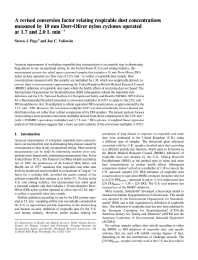Mining Publication: A Revised Conversion Factor Relating Respirable Dust Concentrations Measured by 10-mm Dorr-Oliver Nylon Cyclones Operated at 1.7 and 2.0 L Min^(-1)
Original creation date: March 2009
Accurate measurement of workplace respirable dust concentration is an essential step in eliminating lung disease in any occupational setting. In the United States (U. S.) coal mining industry, this measurement process has relied upon a personal sampler that includes a 10 mm Dorr-Oliver (DO) nylon cyclone operated at a flow rate of 2.0 L min-1 to collect a respirable dust sample. Dust concentrations measured with this sampler are multiplied by 1.38, which was empirically derived, to convert them to measurements approximating the United Kingdom British Medical Research Council (BMRC) definition of respirable dust upon which the health effects of coal mine dust are based. The International Organization for Standardization (ISO) subsequently refined the respirable dust definition and the U. S. National Institute for Occupational Safety and Health (NIOSH) 1995 Criteria for a Recommended Standard presented a conversion multiplier of 0.857 to apply to the 2.0 L min-1 DO (in addition to the 1.38 multiplier) to obtain equivalent ISO concentrations, as approximated by the 1.7 L min-1 DO. However, the conversion multiplier 0.857 was derived indirectly from a limited size distribution data set rather than a direct comparison of the DO samplers. The present analysis focuses on providing a more accurate conversion multiplier derived from direct comparisons of the 2.0 L min-1 (with 1.38 BMRC equivalency multiplier) and 1.7 L min-1 DO cyclones. A weighted linear regression analysis of this database suggests that a more accurate estimate of the conversion multiplier is 0.815.
Authors: SJ Page, JC Volkwein
Peer Reviewed Journal Article - March 2009
NIOSHTIC2 Number: 20035162
J Environ Monit 2009 Mar; 11(3):684-689
See Also
- Best Practices for Controlling Respirable Dust in Coal Mines
- A Comparative Evaluation of the Differential-Pressure-Based Respirable Dust Dosimeter with the Personal Gravimetric Respirable Dust Sampler in Underground Coal Mines
- Differential Pressure Response of 25-mm-Diameter Glass Fiber Filters Challenged with Coal and Limestone Dust Mixtures
- Evaluation of LIDAR as a Novel Remote Dust Sensing Technology
- Reducing Silica and other Respirable Hazards in the Industrial Minerals and Metal/Nonmetal Mining Industries
- Selected Publications on EVADE Software, Helmet-CAM, Dust Exposure, and Behavioral Studies
- Status of a Tapered Element, Oscillation Microbalance-Based Continuous Respirable Coal Mine Dust Monitor
- Technology News 463 - Machine-Mounted Continuous Respirable Dust Monitor
- Technology News 509 - A New Method to Clean Dust From Soiled Work Clothes
- Test Report on the Machine-Mounted Continuous Respirable Dust Monitor
- Content source: National Institute for Occupational Safety and Health, Mining Program


 ShareCompartir
ShareCompartir
